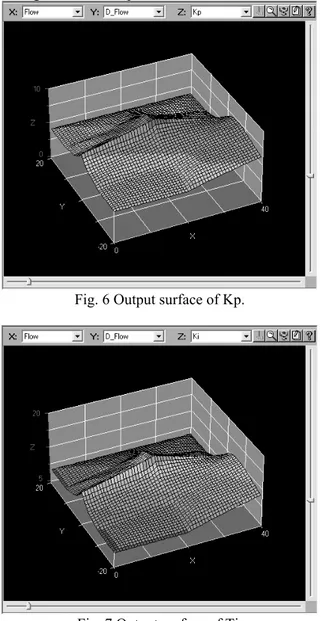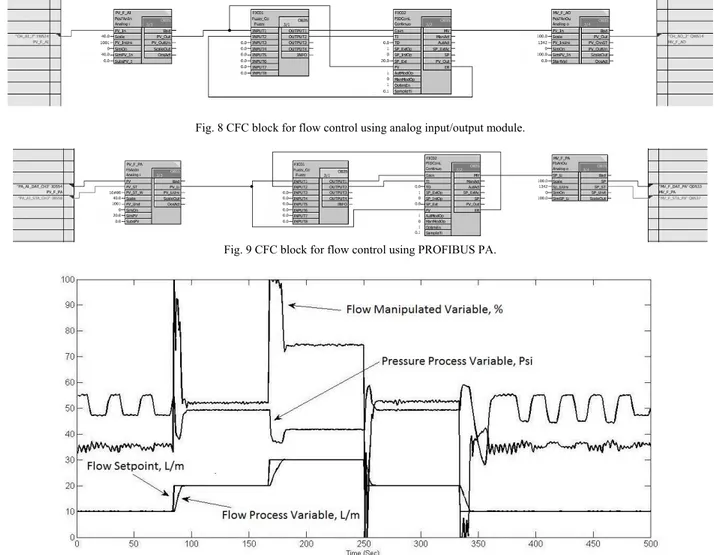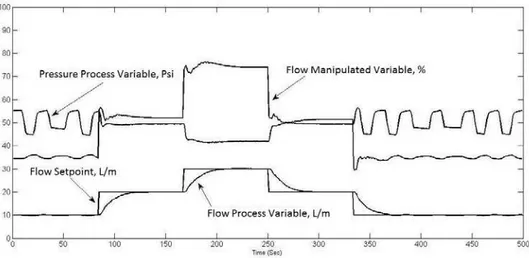Abstract—In case of changing a communication between
field instruments and controller from analog signal into digital signal or of changing a model of plant, performance of controller is degraded because of the fixed controller parameters such as PID controller. To solve this problem, a tuning PID controller is proposed. One of a popular self-tuning method is self-self-tuning fuzzy. Many researchers have been presented the self-tuning fuzzy PID controller. In this paper, we present implementing of self-tuning fuzzy PI controller for flow control system. Both fuzzy and PI controller is implemented on distributed control system (DCS) as controller at which communication between field instruments and distributed control system is via both the analog input and output modules as analog signal in range of 4-20mA and digital signal as Profibus PA. The PI controller parameters, proportional gain and integral time, from auto-tuning method is used to control plant, flow control system, by using analog signal at which result shows that flow process variable reaches to flow set point. The same PI controller parameters is applied for PROFIBUS PA at which results shows that flow process variable oscillates because of effect of delay-time taken place from communication between field instruments and distributed control system.
Index Terms—Process Control System 7 (PCS7),
FuzzyControl++ self-tuning fuzzy, PI controller, flow control system.
I. INTRODUCTION
INCE PID controller is widely used in industrial process
by using programmable controller or distributed control system. Disadvantage of PID controller is that when model of system is changed, its performance is then degraded. To solve this problem, one method is applying adaptive control by online tuning controller parameters such as proportional gain, integral time and derivative time of PID controller dependent on a process model. Fuzzy control system is proposed by many reports for tuning controller parameters [1],[3]. Most reports is focused to verification that Fuzzy system as function of self-tuning is validity by simulation. For this paper, self-tuning PI controller is implemented on distributed control, Process Control System PCS 7 V7.1 [3],[4],[5], together with FuzzyControl++ software [6] for developing Fuzzy system. The networked control system is setted up with PROFIBUS PA to show effect of delay-
Manuscript received December 29, 2014; revised February 8, 2015. K. Assawathanatorn, K. Anuntahirunrat, and S. Chitwong are with the department of Instrumentation and Control Engineering, Faculty of Engineering, King Mongkut’s Institute of technology Ladkrabang, Ladkrabang, Bangkok 10520 THAILAND. (e-mail : khemjira_a @yahoo.com.au {kakongsa, kcsakrey}@kmitl.ac.th).
time comparing with analog input/output module. Flow control system is used to experiment consisting of flow transmitter, control valve, current to PROFIBUS PA converter, PROFIBUS PA to current converter, DP/PA coupler, and distributed control system installed PCS 7 V7.1 with FuzzyControl++ by using Windows XP.
This paper is organized as following. The Section II briefs plant descriptions. Section III presents the self-tuning fuzzy PI controller. Section IV describes method of implementation in dcs system. Results and discussions are given in section V. Conclusion is summarized in section VI.
II. PLANT DESCRIPTIONS
A. Brief description of the Process
The pressure tank system has been setted up in our laboratory, comprising of three parts. First part is water supply system consisting of storage water tank, water pump with inverter to control speed of induction motor, and surge tank with pressure transmitter (PT1, range : 0-100 psi, output : 4-20 mA) as feedback pressure signal to inverter for controlling pressure value in surge tank. Second part is pressure control system consisting of pressure tank, control valve (CV1, range : 0-100 %, input : 4-20 mA), and pressure transmitter (PT2, range : 0-60 psi, output : 4-20 mA). Third part is flow control system consisting of control valve (CV2, range : 0-100 %, input : 4-20 mA) and flow transmitter (FT1, range : 0-40 l/min, output : 4-20 mA). For this paper, flow control system is employed to experiment only.
B. Control System Configuration
To implement a control system, control system architecture from Siemens is comprised of automation station (AS), engineering station (ES), and operator station (OS). SMAR field instruments [7] are used as field instruments together with PROFIBUS DP/PA coupler. Hardware configuration is configured by STEP 7 with PCS7 V7.1 in HW Conf. AS consists of universal rack UR2ALU, power supply PS407, CPU 416-3 PN/DP V5.2 with IF964-DP as PROFIBUS IF964-DP master system and with Ethernet as PROFINET IO system, and analog input and output module. ES is used for hardware configuration, control programming development, and field instruments configuration. PROFIBUS DP master system and Ethernet as PROFINET IO system of the CPU 416-3 PN/DP in AS are used to connect with PROFIBUS DP/PA coupler FDC 157-0 for linking with field instruments SMAR IF303 (current 4-20 mA to PROFIBUS PA signal) and SMAR FI303 (PROFIBUS PA signal to current 4-20 mA) and ES,
Implementation of Self-Tuning Fuzzy PI
Controller on DCS for Flow Control System
K. Assawathanatorn, K. Anuntahirunrat and S. Chitwong
respectively. Also MPI/DP of the CPU 416-3 PN/DP in AS is configured as MPI for connection to ES via the CP5611 PROFIBUS DP card for downloading a fuzzy parameters only.
Analog input module is used to connect with pressure and flow transmitter in 4-20 mA current together with IF303. Analog output module is used to connect with both control valves in 4-20 mA current by alternation between FI303 and analog output module.
C. Field Instruments Configuration
The first step to use a PROFIBUS PA field instrument is configurating its parameter to corresponding with a controlled process. SMAR IF303 and FI303 [x] are used to convert 4-20 mA current from a original instrument (flow transmitter) to PROFIBUS PA signal and PROFIBUS PA signal to 4-20 mA current for a original control value, respectively. Both the IF303 and FI303 is configurated by PDM program from Siemens. Second and third channel of IF303 is connected to PT2 and FT1, respectively. Analog input block as function block of IF303 is configurated for 4-20mA to 0-60 psi and to 0-40 l/min, respectively, the 0-60 psi and 0-40 l/min are in PROFIBUS PA signal. Second and third channel of FI303 is connected to CV1 and CV2, respectively. Analog output block as function block of FI303 is configurated for 0-100 % PROFIBUS PA signal to 4-20mA.
III. SELF-TUNINGFUZZYPICONTROLLERDESIGN A. Structure of self-tuning fuzzy PI controller
The general control system structure is consisting of three parts: (1) Fuzzy system, (2) PI controller, and (3) process shown in Fig. 1.
Fig. 1 Block diagram of self-tuning Fuzzy PI controller. The mentioned Fuzzy system is different from traditional. Error is differential between flow set point and flow and flow from process employed which is not change of error. Fuzzy subset of input as Error is Negative Big-NB, Negative Small - NS, Zero - Z, Positive Small - PS, Positive Big - PB {NB,NS,Z,PS,PB}and Flow Negative - N, Zero - Z, Positive - P {N,Z,P}and output as Kp and Ti is {Best, Med, Pool}. Membership functions of input as Error, flow and output as Kp, Ti are shown in Fig. 2 to 5. PI controller is traditional PI controller widely used in industrial process. Model of process for flow system is first order plus dead time FOPDT consisting a process gain K, time constant , time lag Td.
Fig. 2 Membership function of flow.
Fig. 3 Membership function of error.
Fig. 4 Membership function of Kp.
Fig. 5 Membership function of Ti. B. Self-tuning Fuzzy rule
Fuzzy rule is developed by experience of human. The inference rule form for self-tuning Fuzzy is
Rule 4 : If Error is NS, Flow is N, then Kp, Ti is Best Rule 5 : If Error is NS, Flow is Z, then Kp, Ti is Med Rule 6 : If Error is NS, Flow is P, then Kp, Ti is Pool Rule 7 : If Error is Z , Flow is N, then Kp, Ti is Med Rule 8 : If Error is Z , Flow is Z, then Kp, Ti is Pool Rule 9 : If Error is Z , Flow is P, then Kp, Ti is Med Rule 10 : If Error is PS, Flow is N, then Kp, Ti is Best Rule 11 : If Error is PS, Flow is Z, then Kp, Ti is Pool Rule 12 : If Error is PS, Flow is P, then Kp, Ti is Best Rule 13 : If Error is PB, Flow is N, then Kp, Ti is Best Rule 14 : If Error is PB, Flow is Z, then Kp, Ti is Best Rule 15 : If Error is PB, Flow is P, then Kp, Ti is Best Fuzzy tuning rule for Kp, Ti is shown in Table 1.
Table 1
Fuzzy Tuning Rule for Kp, Ti
Kp Flow
Ti N Z P
NB Best Best Med NS Best Med Pool Error Z Med Pool Med PS Best Pool Best PB Best Best Best
By using fuzzy inference system and the mentioned input and output membership function, The output surface of Kp and Ti shown in Fig. 6 and 7 respectively indicates that a quantizing intervals of Kp is of 0 – 10 and Ti of 5 – 20 s.
Fig. 6 Output surface of Kp.
Fig. 7 Output surface of Ti.
IV. IMPLEMENTATION IN DCSSYSTEM
In this paper, distributed control system from Siemens as PCS 7 V7.1 is employed to implementation for experimental results. For developing the self-tuning fuzzy consisting of membership function, Fuzzy rule design followed as Topic III, the FuzzyControl++ V6 software from Siemens is employed to generate the designed fuzzy data corresponding with a data block DB generated from Fuzzy CFC library. All of control programming development is in the continuous function chart CFC by using standard libraries consisting of input/output functions for communication as analog signal – analog input/output module and digital signal – PROFIBUS PA and DP, PID control function, and Fuzzy control function. Standard PID control function, namely PID_ConL (FIC102), Fuzzy control block, namely Fuzzy_Co (FIC101), input and output function for PROFIBUS PA, namely FbAnIn (PV_F_PA) and FbAnOu (MV_F_PA), and for analog input/output module, namely Pcs7AnIn (PV_F_AI) and Pcs7AnOu (MV_F_AO) in PCS7 libraries for CFC is applied. Fig. 8 shows the CFC block for flow control program by using analog input/output module as analog signal. Fig. 9 shows the CFC block for flow control program by using PROFIBUS PA as industrial networked control system.
V. RESULTS AND DISCUSSION
Experimental tests were carried out to evaluate the self-tuning Fuzzy PI controller for flow control system by using communication between controller and field instruments via both analog input/output module and PROFIBUS PA utilizing continuous function chart CFC.
First, the delay-time effect to PI controller performance for flow control system when using analog input/output module and PROFIBUS PA is shown. PCS7 PID-tunner is used to optimizing the PI controller parameters at which controller parameter: Kp=33.513 and Ti=1.991, process parameter: K=0.439, =2.083s, Td=0.286s where K is process gain, is time constant, Td is time lag. Fig. 10 shows the response of PI controller for flow control system when changing a flow set point. Using the same PI controller parameter, PROFIBUS PA is used to communication between controller and field instruments. Fig. 11 shows the response seeing that flow response is oscillation at which flow control system can not control when protocol for communication is changed or updated. To solve this problem, the PI controller must be re-tuned. at which controller parameter: Kp=4.261 and Ti=8.578s, process parameter: K=0.434, =5.395s, Td=1.315s. Fig. 12 shows the response of PI controller seeing that flow response reaches to flow set point.
VI. CONCLUSION
From experimental results, when time constant and time lag of system is increase, controller performance is then degraded because of more delay-time. To solve this problem permanently for effect of delay-time, adaptive control must be applied. The self-tuning PI controller is implemented on
PCS7 V7.1 with FuzzyControl++ from Siemens for flow control.
ACKNOWLEDGMENT
The authors thank Mr. Narupon Panakulchiwit for their support of this project.
Fig. 8 CFC block for flow control using analog input/output module.
Fig. 9 CFC block for flow control using PROFIBUS PA.
Fig. 10 Response of PI controller with Kp=33.513 and Ti=1.991s using analog input/output module.
Fig. 12 Response of PI controller with Kp=4.261 and Ti=8.578s using PROFIBUS PA (re-tuned).
Fig. 13. Response of self-tuning Fuzzy PI controller using analog input/output module.
Fig. 14 Response of self-tuning Fuzzy PI controller using PROFIBUS PA.
REFERENCES
[1] Z.-Y. Zhao, M. Tomizuka, and S. Isaka, “Fuzzy gain scheduling of PID controllers,” IEEE Trans. On System, Man and Cybernetics, vol.
23, Sept. 1993, pp. 1392-1398.
[2] A. Visioli, “Tuning of PID controllers with fuzzy log,” IEE Proc.-Control Theory Application, vol. 148, No.1, Jan. 2001, pp. 1-8. [3] Siemens AG A&D AS CS 2 PA Systems Support Process Automation
and A&D AS MP 7 Marketing & Promotion SIMATIC PCS7,
SIMATIC PCS7 on Tour – Basic, Siemens AG, Karlsruhe, Germany,
March 2007.
[4] Siemens AG, SIMATIC CFC for S7 Continuous Function Chart,
Siemens AG, Karlsruhe, Germany, 2003.
[5] Siemens AG, SIMATIC PCS7 PID Control with Gain Scheduling and
PID Tuning, Siemens AG, Germany, 2009.
[6] Siemens AG, FuzzyControl++ User’s Manual, Siemens AG,
Karlsruhe, Germany, 2003.
[7] SMAR, IF303 and FI303 Operation & Maintenance Instruction



